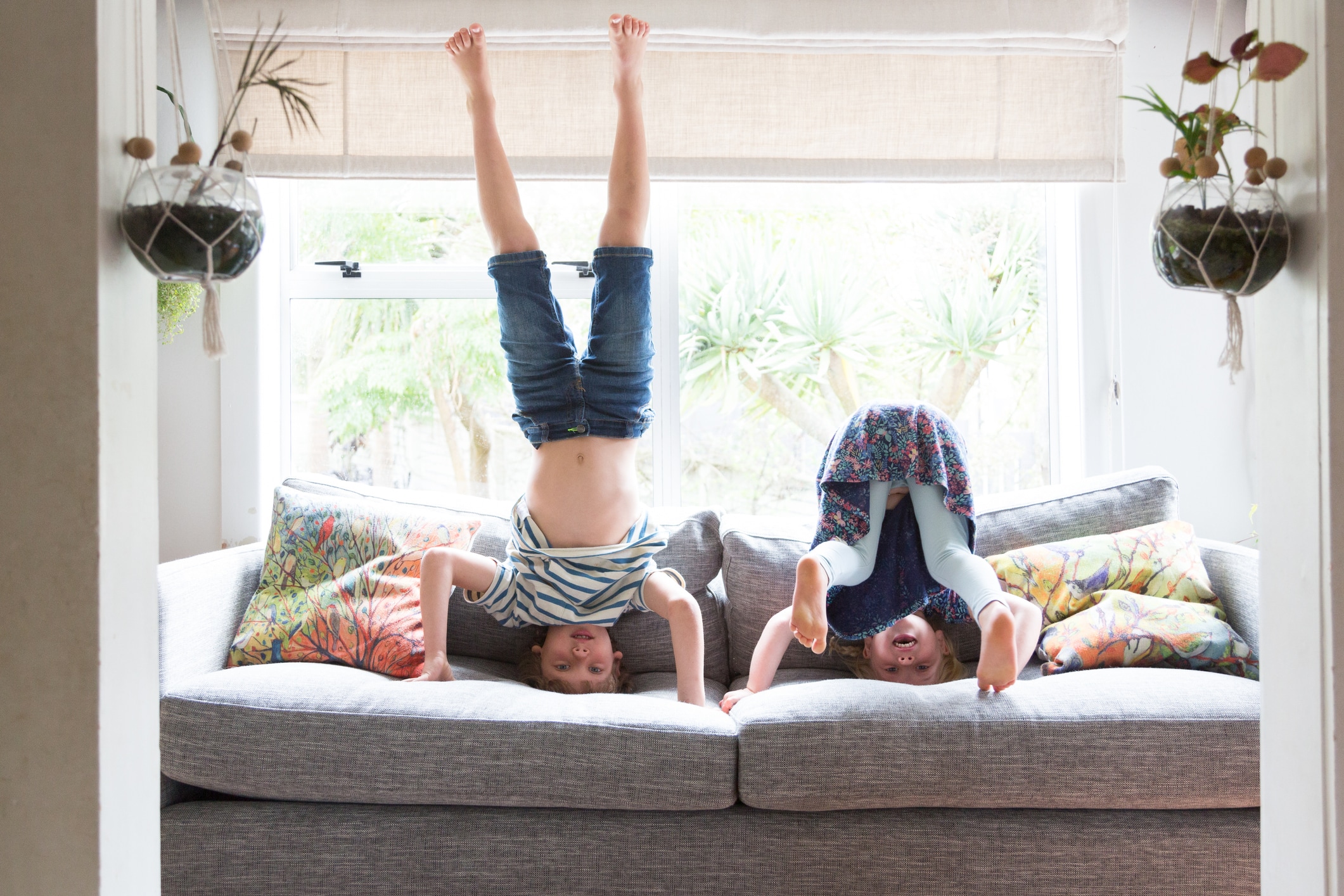When the term therapy comes to mind, you might envision two people seated across from one another conversing in a stuffy room — one a bespectacled doctor with a notepad and judgmental nod, the other an anxiety-ridden patient sprawled on a sofa. But therapy — especially when it comes to therapy for kids — is far more diverse, dynamic and capable of customization than you might think, says Laurie Singer, a licensed psychotherapist and board-certified child and family therapist in Camarillo, California.
“When therapy involves children, the therapeutic setting may differ,” explains Singer. “A therapy session might involve working with the family, involving the parents and sometimes siblings in the session.” Or, in the case of play or art therapy, the additional stimulus could be non-familial entirely.
Regardless of which type of therapy for children you choose, Singer says that the skills a kid hones through the process can contribute to healthy development into adulthood.
That said, not all children will benefit from the same type of therapy — and knowing if your child is a good candidate for a certain type takes some exploration (and consulting with a clinical therapist or psychologist). “I’ve used a wide variety of therapies for children over my 20 years in practice and have found that the child’s concerns and issues, along with the family dynamics, helps determine which type of therapy will be most effective.”
Here, experts outline the major types of therapy for kids, their benefits as well as how to identify the right type for your child.
Key takeaways
- Therapy for children comes in many forms — like play, art and CBT — based on their specific needs and age.
- Some approaches involve parents and focus on family dynamics.
- The right therapy depends on the child’s situation and should be chosen with guidance from a healthcare provider.
Acceptance and commitment therapy (ACT)
As Traci S. Williams, a board-certified psychologist specializing in childhood and adolescent psychology, notes, this type of therapy has a distinct tie-in to meditation and mindfulness practices. “ACT encourages accepting negative thoughts, feelings and experiences instead of avoiding them,” she notes. In other words, as Williams notes, children who engage in this type of therapy might be stuck on something in their life that’s preventing them from moving forward — be it chronic pain from an injury to a death in the family to general stress from school or their social life. ACT encourages the child to (gently) accept whatever hard or immobile truth is troubling them and establish a path forward.
Why it’s beneficial: Because of ACT’s ubiquitous nature (it can be used to treat chronic conditions, traumatic events and just general stress), Williams notes that this therapy can be useful for a wide range of children and of all ages. Studies have also shown that it’s particularly effective in helping children overcome past traumatic events and difficult emotions.
Animal-assisted therapy
As the name suggests, animal-assisted therapy involves using trained animals to help reduce a child’s stress in therapy, says Williams. “This form of therapy can help treat many presenting problems,” she notes. “However, it might not be appropriate for children who are afraid or allergic to animals.”
Why it’s beneficial: Animal-assisted therapy isn’t necessarily a distinct mental health science — rather, as Williams notes, it’s a tool that therapists and psychologists can add on to other forms of treatment to encourage participation and boost mood. For example, many children’s hospitals use animal-assisted therapy to encourage children to interact more with others and staff, take their medication or calm nerves during or prior to painful or frightening procedures. A 2019 PLOS One study found that use of trained dogs could help boost the effectiveness of therapy in adolescent children.
Art therapy
“Art therapy is a form of psychotherapy that engages with the creative process,” explains Hephzibah Kaplan, an art psychotherapist and director of the London Art Therapy Centre. “Whereas the relationship between the therapist and client in verbal therapy is dyadic, in art therapy there is a triadic relationship between the therapist, the client and the image.”
Why it’s beneficial: As Kaplan reiterates (and studies suggest), oftentimes children (especially young children) can struggle to find the right words to express their feelings or desires. Art therapy helps children bridge that language or speech gap. “The image [in art therapy] can be a bridge for many expressions, releases, catharses, confusions as well as discoveries and untanglings,” he notes.
Cognitive behavioral therapy (CBT)
As Dorothy McLeod Loren, a clinical psychologist and the clinical senior manager at Brightline, a mental health startup for kids and teens, explains, cognitive behavioral therapy (CBT) can treat a wide range of mental struggles among children and teens. “CBT is a therapy used among children with anxiety, depression and even concerns like post-traumatic stress disorder (PTSD),” she says. “It offers children and families tools to help change distressing emotions and unhelpful thoughts and behaviors.”
Why it’s beneficial: CBT can take on a variety of forms and styles, including other therapy types on this list — from ERP to trauma-focused therapy. And while McLeod Loren says that children undergoing a CBT therapy regimen will often receive 12 timed sessions, she notes that families can often see tangible results in as few as two sessions.
Dance-movement therapy
“In this therapy, movement, children and teens are able to integrate the physical, emotional, social and cognitive parts of themselves through movement,” Williams says. “While it can help with a variety of presenting problems, it is often used to treat issues with body image, self esteem and communication problems.”
Why it’s beneficial: Like art therapy, children who might struggle to find the words to express their emotions (or are simply nervous or afraid to voice what’s on their mind) might benefit especially from dance-movement therapy. It’s also particularly helpful in improving communication and emotion-expression skills in children with autism, as one 2021 Frontiers in Psychology study found.
Join Care for free
Dialectical behavior therapy (DBT)
Singer notes that dialectical behavior therapy (DBT) stems from CBT, but with one main difference: “There is greater emphasis placed on encouraging the individual to develop a standard set of skills in DBT,” she explains. While she says these skills can range, one common one is mindfulness and focusing on the present moment, which can help a child “reduce the emotional stress that comes with constant worry about the past or future,” Singer adds.
Why it’s beneficial: As The Child Mind Institute explains, while DBT was originally developed for children with borderline personality disorder, it can treat a host of conditions — from anxiety and depression to even drug abuse.
Exposure response and prevention (ERP)
Alison Stoner, a clinical psychologist and senior clinical manager at Brightline, explains that exposure and response prevention therapy (ERP) is another CBT-derived form of treatment that’s especially helpful for children with obsessive-compulsive disorder and intense fears. She notes that therapists typically work with children to pinpoint obsessive thoughts that provoke compulsive acts or fear, then try to alleviate that stress and provide a sense of safety.
Why it’s beneficial: As the name suggests, ERP addresses a child’s deep-seeded anxieties and fears head-on with direct exposure to the fear — making it especially powerful and potent. “Over time, the connection between fear and compulsive behaviors is broken,” Stoner explains. “The feared thoughts, images and situations become less distressing, and the [child] is empowered to face these fears without the use of compulsions.”
Eye movement desensitization and reprocessing (EMDR)
This therapy type is useful for children who’ve recently experienced a traumatic event, says Williams. “EMDR is used to treat the distress and negative thoughts experienced after a traumatic event,” she notes.
Essentially, children undergoing this therapy will work through processing traumatic memories — often through “triggers” like the smell or noise associated with a stressing event — while moving their eyes along certain paths, she notes.
Why it’s beneficial: Unlike other types of therapies, sessions to resolve trauma through EMDR are often contained within the session. In other words, children and families typically don’t need to do a ton of outside reinforcement or homework, as The Cleveland Clinic notes.
“Family therapy often addresses a family system’s difficulty — like poor communication or frequent yelling matches — rather than a child’s clinical diagnosis, like depression or anxiety.”
— Dorothy McLeod Loren, clinical psychologist
Family therapy
As McLeod Loren describes, while other types of therapies on this list single out the child as the individual needing intervention, family therapy puts the spotlight on the unit.
“A family therapist might help a family observe patterns of interaction and communication within the family unit and change these to be more effective,” she notes. “Family therapy often addresses a family system’s difficulty — like poor communication or frequent yelling matches — rather than a child’s clinical diagnosis, like depression or anxiety.” However, she notes that family therapy is often coupled with other forms of therapy to ensure the best result for the child.
Why it’s beneficial: If a child is struggling, there’s a chance the surrounding unit might be struggling, too, making family therapy an especially holistic approach to mental health. And it can take on multiple forms, too: McLeod Loren says that, in her experience, family-based treatment for eating disorders can often be one of the best ways to help young people improve their relationships with food.
Motivational interviewing (MI)
As Williams explains, if a child is struggling with substance abuse or is having difficulty following a particular direction (say, a medication or treatment plan from a doctor), motivational interviewing can be a solid short-term solution. “MI helps young people change their behaviors by tapping into their internal motivations to do so,” she notes. “This treatment is typically short-term and effective for health-related concerns.”
Why it’s beneficial: Studies have shown that MI is proven effective in treating a wide range of situations, including alcohol, drug and tobacco use, unhealthy diet patterns and adherence to medication regimens.
Parent-child interaction therapy (PCIT)
Parent-child interaction therapy is most helpful for children between 2 and 12 years old and (oftentimes) who are exhibiting behavioral problems like destructive behaviors or tantrums — and who are sometimes considered at-risk for more serious behavioral issues, says Singer. Therapists work directly with children and parents (often through play) to decrease harmful behaviors.
Why it’s beneficial: Like family therapy, the parent-child (or caregiver-child) relationship is at the forefront for this therapy type. “During PCIT, parents and caregivers learn strategies that increase positive behaviors in children,” Singer explains. “They learn more effective parenting techniques and as a result, the behavior problems of the child will often decrease and the quality of parent-child relationship will improve.” Parents can find a PCIT-certified therapist here.
“Increasing emotional intelligence can take time, but just being able to put emotions into words, and understanding how the connect to our behaviors, can make an enormous difference in a child’s life.”
— Laurie Singer, licensed psychotherapist
Play therapy
Ideal for children between the ages of 3 and 12, play therapy “is used to help the child explore emotions and deal with unresolved trauma,” says Singer. “Through play, children learn new coping strategies and how to replace inappropriate behaviors.” The type of play can take on a variety of forms, from painting to dance to toys. “Children might use play therapy to act out their fears and anxiety,” Singer adds. “The therapist engages in play with the child and as a result of that play, the child becomes less guarded and more likely to share their feelings without feeling pressured.”
Why it’s beneficial: Research suggests play therapy can be an effective tool in helping younger children express complex or difficult feelings. Those studies also suggest that the positive effects of play therapy are compounded when parents are involved in treatment.
Psychodynamic therapy
Psychodamic therapy is all about contextualizing negative feelings and behaviors by determining what past events or traumas might be causing them, says Singer. “It’s a form of talk therapy based on the work of Sigmund Freud,” she notes. “The goal is for the child to speak freely about whatever comes to mind and the therapist will look for clues that may open up a connection to past experiences and traumas.”
Why it’s beneficial: Singer says that, while this type of therapy might seem a bit intense for children (or maybe impossible if the child is young and can’t articulate their experiences or emotions well), the right psychodynamic therapist for children will be a pro at extracting information — oftentimes through play. “Like other talk therapies, increasing emotional intelligence can take time, particularly with children, but just being able to put emotions into words, and understanding how the connect to our behaviors, can make an enormous difference in a child’s life.”
Trauma-focused cognitive behavior therapy (TF-CBT)
Like traditional cognitive behavior therapy, trauma-focused CBT works to help a child sort through complex emotions. But in this case, the trauma is often related to sexual abuse. “TF-CBT is useful after a traumatic event,” explains Williams. “It helps children, teens and their non-offending caregivers understand how to better cope with the trauma.”
How it’s beneficial for children: A primary goal of TF-CBT is to remove the belief that a child is responsible or to blame for their abuse. Another key benefit and differentiator from traditional CBT: The parent or caregiver for the child who suffered abuse is also often involved in the therapy.
How to find the right therapist for a child
If a child in your life is exhibiting worrying behavior (or you simply know they’re going through something tough), knowing what type of therapy they’re a good candidate for can be challenging. Singer says a go-to starting point should be a primary care physician, as opposed to a psychologist or therapist.
“After recognizing there is a specific problem, I suggest reaching out to the child’s doctor, letting them know what the situation is and ask if they have any recommendations,” she says. “Based on the child’s situation, parents [and caregivers] can then better choose a modality of therapy that will be most effective.”
She notes that many therapies will overlap, and a primary care doctor can help identify particular niche-therapies that may not be suitable. “Art therapy may not be the best fit for a family whose child is noncompliant or has aggressive outbursts,” she explains, noting that in that case, family therapy may be a better fit. “Play therapy might work best for a young child who is grieving over the loss of a loved one or who comes from an abusive home.”
After the doctor has recommended a particular modality of therapy or a therapist, Singer recommends calling the therapist, talking with them, learning more about how they conduct their sessions and the cost of treatment. “This is a time for parents to be open and honest with a professional and get a sense of not just the therapist’s approach, but also their demeanor,” she says. “We don’t ever want to feel pressured so our ‘gut instinct’ can go a long way in making the best choice.”





